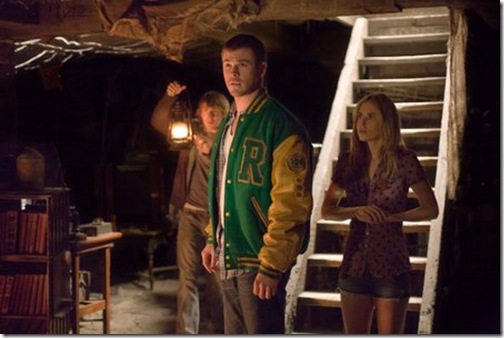As a parody of horror cinema, The Cabin in the Woods is so ingenious, it’s hard to believe nobody thought of it before now.
There have been attempts to reach a similar end, of course: Scream, Shaun of the Dead, Zombieland, Baghead and Behind the Mask all integrated humor and self-consciousness into their narrative toolbox to some extent. But The Cabin in the Woods should be the last word on genre subversion – a witty, jolting, inventive rebuke to every B-horror staple known to man, endowed with the infectious magnetism of an instant cult classic. The second it ended, I wanted to watch it again.
The film’s overriding target for homage/ridicule is horror cinema’s bloodiest chestnut: the moralistic slasher film, wherein inexplicable friends of all shapes and sluttiness congregate for a weekend of hedonism and find themselves hacked to pieces for their promiscuity. Genre touchstones like Friday the 13th, The Texas Chain Saw Massacre and Cabin Fever represent the shades of formal color on the palette of Cabin in the Woods director Drew Goddard and co-writer/producer Joss Whedon, both veterans of sci-fi/fantasy television and both obviously snarky cinephiles.
The Cabin in the Woods begins to play out much like its genre forbears: Cruising in a camper toward their backwoods cabin retreat, five meticulously selected “friends” – a blonde tramp (Anna Hutchison), her just-as-hot but studious brunette bestie (Kristen Connolly), a single-celled jock (Chris Hemsworth), a sensitive egghead (Jesse Williams) and a paranoid stoner (Fran Kranz) – partake in a ludicrous procession of horror film clichés.
Like well-oiled slasher-movie machines running on autopilot, they ignore the creepy redneck soothsayer who warns them of their ominous future, and they enter every dark and dread-inducing orifice in the cabin’s bowels. Paintings on the cabin walls depicting ritual human sacrifice do little to deter their lost weekend of liquor, weed and – naturally – games of “truth or dare.”
Any viewer who has seen more than three horror films in his lifetime would be starting to throw his hands in the air at this point, and would be probably be walking out were it not for those other scenes in the Cabin in the Woods, which feature Bradley Whitford walking and talking, West Wing-style, around a spacious corporate complex with his colleague Richard Jenkins. These scenes are the funniest in the film, and both actors have a blast, but to disclose any more about them would be to spoil the movie’s caustic reveal, one that puts everything we’ve seen before it into new perspective. Even the familiar problem of “Why would person X even be acquaintances with person Y, let alone accompany them on a vacation?” is addressed and quantified through this creative conceit.
The Cabin in the Woods is predicated on a self-effacing irony as thick as a block of frozen gorgonzola, and the digitally enhanced satire only grows richer as it progresses (it literally adds layers). Not to mention bloodier: The mayhem escalates to a level of Grand Guignol gore that earns its R rating in spades. And, as with George A. Romero and John Carpenter in their prime, the action is anchored by social commentary that channels the anxieties of its time, in this case the erosion of privacy in a world where everything is surveilled.
At the risk of ascribing too much profound subtext to a movie in which a retractable bong is used as a weapon against an approaching redneck zombie, suffice it to say that this post-horror film is a pointedly 21st-century concoction.
THE CABIN IN THE WOODS. Director: Drew Goddard; Cast: Kristen Connolly, Fran Kranz, Chris Hemsworth, Jesse Williams, Anna Hutchison, Richard Jenkins, Bradley Whitford, Brian White, Amy Acker; Distributor: Lionsgate; Rating: R; Opens: Friday at most area theaters
